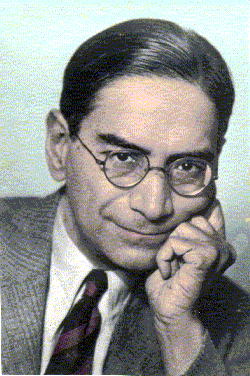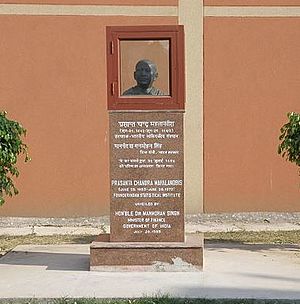Prasanta Chandra Mahalanobis facts for kids
Quick facts for kids
Prasanta Chandra Mahalanobis
|
|
|---|---|

P. C. Mahalanobis
|
|
| Born | 29 June 1893 |
| Died | 28 June 1972 (aged 78) Kolkata, West Bengal, India
|
| Alma mater | University of Calcutta (B.Sc.) King's College, Cambridge (B.A.) |
| Known for | Mahalanobis distance Feldman–Mahalanobis model |
| Spouse(s) | Nirmal Kumari Mahalanobis |
| Awards | Padma Vibhushan (1968) Officer of the Order of the British Empire (OBE, 1942) Fellow of the Royal Society (FRS) Weldon Memorial Prize (1944) |
| Scientific career | |
| Fields | Mathematics, statistics |
| Institutions | University of Cambridge Indian Statistical Institute |
| Doctoral advisor | William Herrick Macaulay |
| Doctoral students | Samarendra Roy |
| Other notable students | Raj Chandra Bose C.R. Rao |
| Signature | |
Prasanta Chandra Mahalanobis (born June 29, 1893 – died June 28, 1972) was a famous Indian scientist. He was also a brilliant statistician. He is known for creating the Mahalanobis distance. This is a special way to measure differences in data. He was also a key member of India's first Planning Commission. This group helped plan India's future after it became independent.
Mahalanobis did important studies on human body measurements. He also started the Indian Statistical Institute. He helped create ways to do large-scale surveys. Because of his work, many people call him the "Father of Statistics in India."
Contents
Early Life and Education
Prasanta Chandra Mahalanobis came from a well-known family. They lived in Bikrampur, which is now in Bangladesh. His grandfather, Gurucharan, moved to Calcutta in 1854. He started a successful business there. Gurucharan was also active in social movements. He was part of the Brahmo Samaj group.
Prasanta grew up in a family that loved learning. Many smart people and reformers were often around him. He went to the Brahmo Boys School in Calcutta. He finished school in 1908. Then he joined Presidency College. Here, he learned from famous teachers like Jagadish Chandra Bose. He earned a science degree in physics in 1912.
In 1913, he went to England to study more. He planned to go to the University of London. But he missed a train and stayed with a friend. This led him to join King's College, Cambridge. He did very well in his studies there. He also enjoyed walking and boating. He even met the famous mathematician Srinivasa Ramanujan.
After his studies, Mahalanobis found a science journal called Biometrika. He was very interested in it. He bought all the past issues and took them back to India. He realized how useful statistics could be. He started using statistics to solve problems. These included issues in weather and human studies.
In Calcutta, Mahalanobis met Nirmalkumari, also known as Rani. They got married in 1923.
Founding the Indian Statistical Institute
Mahalanobis and his friends were very interested in statistics. They formed a small group at Presidency College. On December 17, 1931, Mahalanobis held a meeting. With a few colleagues, he decided to create the Indian Statistical Institute (ISI). It officially started on April 28, 1932.
The institute began in a small room at Presidency College. Its first-year cost was very low. But it grew quickly. Many talented people joined Mahalanobis. They helped the institute become famous. A key person who helped was Pitambar Pant. He worked for Prime Minister Jawaharlal Nehru. Pant had studied statistics at ISI.
In 1933, the ISI started its own journal. It was called Sankhya. This journal was like Biometrika, which Mahalanobis admired. The institute also began training students in 1938.
In 1959, the Indian government recognized ISI. It was declared an important national institute. Today, the methods developed at ISI are used worldwide. Even the World Bank and the United Nations use them. Experts say that ISI is a world leader in statistics. It is amazing that it was built entirely in India.
Key Contributions to Statistics
The Mahalanobis Distance
The Mahalanobis distance is a very important tool in statistics. It helps measure how different a data point is from a group of data. It is used in many areas. These include grouping similar things together and classifying them.
Mahalanobis first introduced this idea in 1930. He used it to study how different groups of people were related. He met Nelson Annandale, who was a director at the Zoological Survey of India. Annandale asked him to study measurements of Anglo-Indians in Calcutta. Mahalanobis used this data. He wanted to see how European and Indian marriages affected people's features. He also looked at whether specific Indian castes were involved.
His studies showed that Anglo-Indians were a mix of Europeans and people from Bengal and Punjab. He also found that higher castes were more often involved in these mixes. This work led him to create the "D²" measure. This measure is now called the Mahalanobis distance. It helps compare and group populations. It works no matter what units are used for measurement.
Sample Surveys
Mahalanobis also made big contributions to large-scale surveys. He introduced the idea of "pilot surveys." These are small test surveys done before a big one. He also showed how useful sampling methods are. Sampling means studying a small part of a group to learn about the whole group.
His early surveys (1937-1944) covered many topics. These included how people spent money and their tea-drinking habits. They also looked at public opinion and crop sizes. Famous statisticians praised his work. Harold Hotelling said Mahalanobis's sampling methods were very accurate. Ronald Aylmer Fisher said ISI led the way in sample surveys.
Mahalanobis also created a method to estimate crop yields. Statisticians would cut crops in a small circle to measure them. This helped the government understand food production.
Later Life and Legacy
In his later years, Mahalanobis was a member of India's Planning Commission. He played a big role in India's first five-year plans. These plans guided India's development after it became independent. He focused on making India more industrial. His ideas, known as the Mahalanobis model, were used in the Second Five Year Plan.
In the 1950s, Mahalanobis also helped bring the first digital computers to India. He was also interested in culture. He worked with the famous poet Rabindranath Tagore. He even served as Tagore's secretary during his travels.
For his great work, Mahalanobis received the Padma Vibhushan. This is India's second-highest civilian award. He died on June 28, 1972, just before his 79th birthday. He was still actively working and researching.
Honours and Recognition
Mahalanobis received many awards and honours:
- Fellow of the Indian Academy of Sciences (1935)
- Fellow of the Indian National Science Academy (1935)
- Officer of the Order of the British Empire (1942)
- Weldon Memorial Prize from the University of Oxford (1944)
- Fellow of the Royal Society, London (1945)
- President of Indian Science Congress (1950)
- Honorary Fellow of the Royal Statistical Society, UK (1954)
- Foreign member of the Academy of Sciences of the USSR (1958)
- Honorary Fellow of King's College, Cambridge (1959)
- Fellow of the American Statistical Association (1961)
- Padma Vibhushan (1968)
In 2006, the Indian government decided to celebrate his birthday, June 29. It is now "National Statistics Day" in India. On his 125th birthday in 2018, a special coin was released in his honour.
See also
 In Spanish: Prasanta Chandra Mahalanobis para niños
In Spanish: Prasanta Chandra Mahalanobis para niños
- List of Indian mathematicians



